What happens after the pine trees go

Cleaning up the mess left behind after you harvest a stand of pine trees.
Words & images: Rebecca Stewart
Our small pine tree block was harvested last winter. It wasn’t ideal timing, but as it was only a few hectares and we’re a long way from anywhere, our options were limited.
We feel closely connected to our land, and the pine trees always felt like interlopers. They should never have been part of this landscape, planted on a few gentle sloping areas in a steep, rugged bush valley. In our wet environment, they were also hazards, with trees falling or breaking after every rain or wind event.

As they were at harvest age, we decided it was better to remove them and use the land for grazing.
Initially, the contractors told us they’d be here in late spring 2020, but they didn’t arrive until winter 2021.
The impact of their heavy machinery on the sodden soil in high rainfall country was immense. Massive track ruts filled with water every time it rained. Branches, even whole logs, were churned into the mud. In the boggiest areas, logs were deliberately sunk to create ’platforms’ so the heavy machinery wouldn’t go belly deep into the mud.
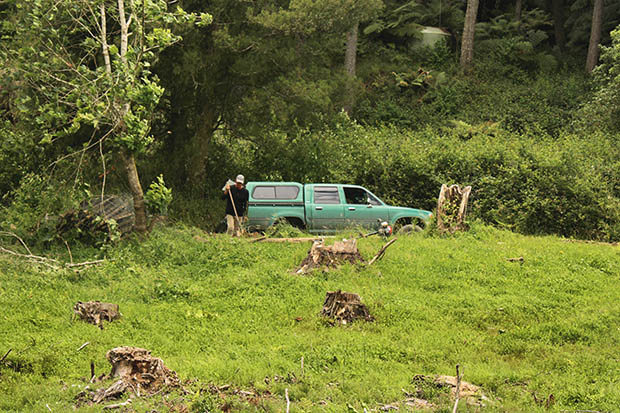
Our plan to turn the area into pasture seemed a very distant dream. Numerous breakdowns and another lockdown delayed the harvest time, and it wasn’t finished until early September.
That left us with the clean-up to end all clean-ups.
Strategy 1: clearing it by hand
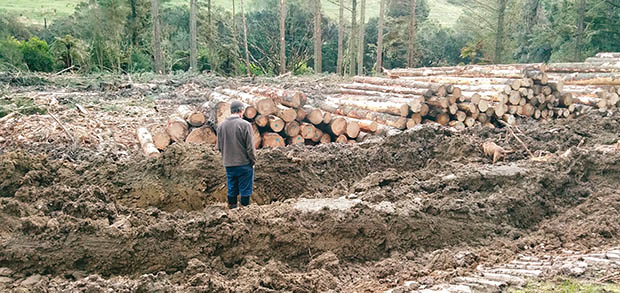
We were offered the use of a tractor, but it was too wet to get it in the paddock, so David started clearing by hand.
The slash was deep on the ground where the pines were dropped, and it was filled with masses of pinecones which made walking through it quite hazardous.
His first step was unblocking a small, spring-fed stream running across the paddock where the pines once stood. The slash had choked its flow, creating a saturated mess in the middle.
He learned fast that it was best to wear work gloves – several large splinters went up under his fingernails on the first day.
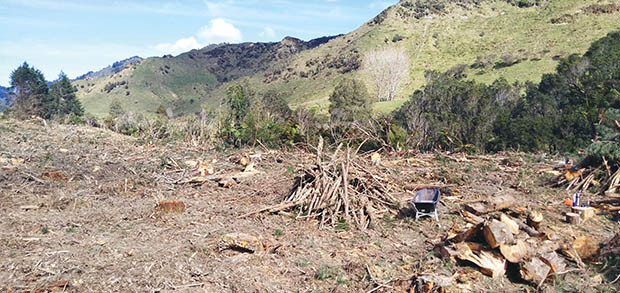
We built pyres of green wood. However, it burns very slowly, and needs to be maintained to keep it hot.
The job was exhausting and relentless. Branch after branch had to be released from the tangled mass or pulled from the ground. Where the harvesting machine had sat, stripping bark from the timber, the pine needles and small debris formed thick mats up to a metre deep, often with large branches or short logs buried in it. David built the fire stacks over the slash as it was easier to burn it than to pull it apart.
We had wanted to make biochar to use in the garden out of as much wood as possible. We quickly realized the best we could do was remove the larger pieces for firewood and burn everything else where it sat.
Over time, the water sitting in the ruts evaporated, and the ground began to dry out, but that created another problem. The soil dried into a solid, almost concrete-like mass with branches and logs sticking out.
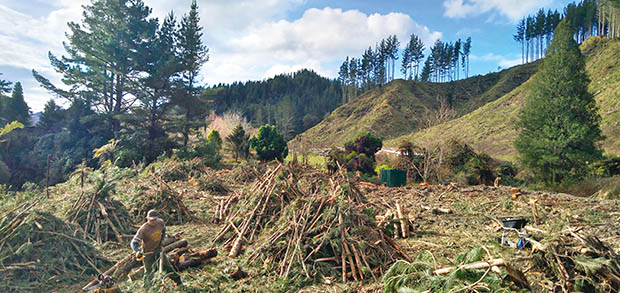
Normally, foresters would replant an area like this with trees, so removing the slash isn’t necessary as they plant straight into it.
But we wanted to clear it back to the soil to sow pasture, which meant removing as much of it as possible.
We spent days at a time burning pyres, adding more slash as they reduced in size. The green piles were slow to burn, with whole days spent maintaining them. Drier piles burnt hot and fast but often tried to escape, burning through the bark, needles, and twigs on the ground.
Our firewood piles were huge. We cut short logs and stumps into rings, larger branches to a more manageable length.
It took about a week to mostly clear about 1100m² (a quarter of an acre) so it was ready for reseeding. Our goal was to sow on the go and establish pasture cover as quickly as possible to avoid further soil loss.
PROS OF HAND-CLEARING
• smaller piles to burn;
• minimal soil disturbance;
• builds lots of muscle, stamina, and endurance;
• low cost.
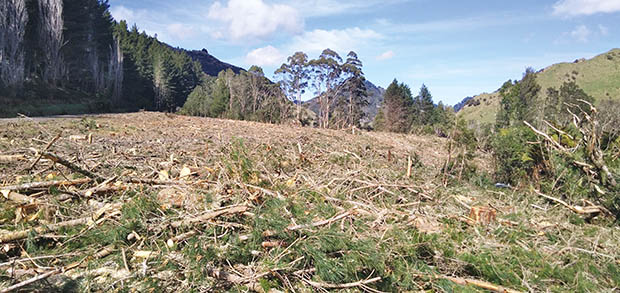
CONS
• very hard work;
• slow and labour intensive;
• wears through lots of work gloves;
• very hard on your body so you need to pace yourself.
Hand clearing several hectares of pine slash is a depressing job. After a day of slogging, exhausting labour, you look up and there’s still a vast expanse of mess. We did this every day for months.
But there were times of enjoyment: a cuppa while admiring the stunning rugged views we could now see; talking to a small robin as it flitted around us; the quiet roar of waterfalls cascading into the ravine.
WHAT IS ‘SLASH’?
This is a forestry term for all the broken branches and timber left behind after felling a large number of trees. Slash will be about 8-10% of the total volume of wood harvested from a stand of pine trees.
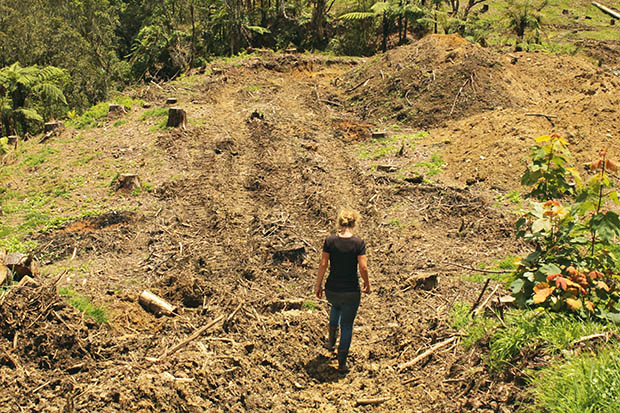
WHY WE LEFT THE STUMPS
Removing stumps is a huge job. We’ll deal with them once we have all the slash cleared, pasture sown, and fences fixed.
Some will be dug out to create farm tracks, but the majority will be left to rot. We’ll try various methods to accelerate the process.
Strategy 2: clearing by machine
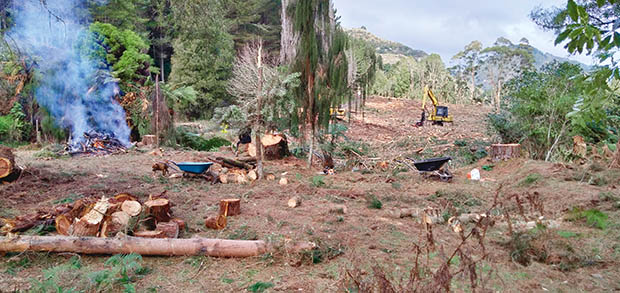
After a few months, with half the big paddock cleared and pasture sown, David moved to a smaller paddock for a bit of variety and a change of view.
That’s when another forestry crew approached him about access across our property so they could avoid using a small bridge on the narrow gravel road.
We were cautious, having seen the impact of heavy machinery on the soil.
But their offer to clean up the remaining mess and create access down the steep banks to our creek was a gamechanger. They brought in two diggers, and in just two days, they’d raked up three mountainous slash piles.
It meant we could sow most of the area straight away, the creek was clear of debris, and we could plant the steep banks with natives.
THE RESULTS
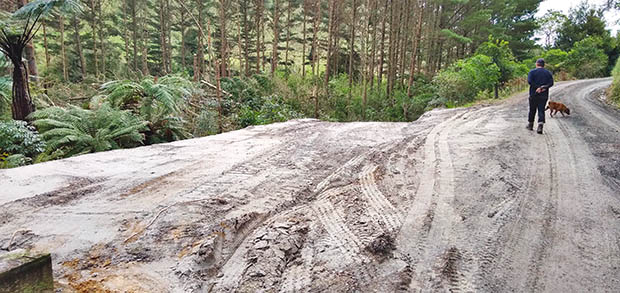
We sowed the first area of grass in late September 2021, but cold temperatures meant we had a long wait for it to germinate. By late December, the area was covered in better pasture than before the pine harvest.
Where we burned the slash piles, the grass is lush and dark green, the potash left behind boosting its growth. In other areas, endemic lotus plants dominate, but we appreciate their rapid growth, which helps prevent weeds from taking over.
We also tried spreading old, crappy hay over the grass seed to help with germination. The result was better quality grass than in areas we left bare, probably because the hay helped retain moisture and contributed extra seeds.
Areas where we’d previously fed hay and silage also had good grass cover.
We have theories about why the hay helped so much. Pasture plants prefer to grow in soil with a 50/50 bacteria-fungi ratio, whereas trees (in our case, the pines) do best in highly fungal soil. By adding in organic matter from the plants you want to grow (in this case, dried grass), the soil adapts more quickly. We had more sporadic pasture growth in areas where we didn’t spread hay, and there were more ‘woody’ weeds that naturally occur in the higher fungal soils.
We also read an interesting study that claims pines don’t create acidic soil. It says the lower pH is a result of the damp, shady conditions created by the close planting in a wet environment (present in both pine plantations and native forest).
The theory is that by removing the conditions that create acidity, and supporting the soil’s natural processes, the soil pH slowly adjusts to suit the existing plants (in our case, grass).
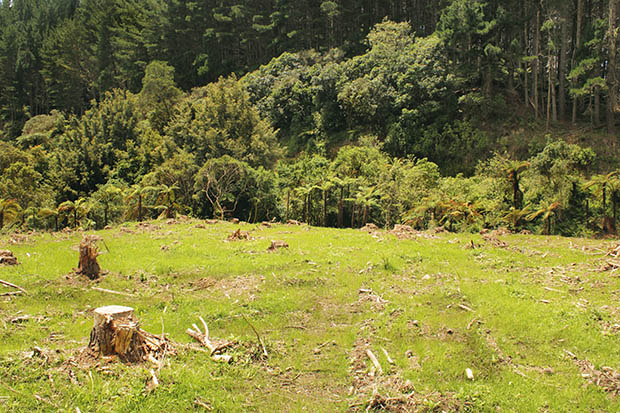
THE WEEDS
The weeds are there too: inkweed, betony, foxglove, thistles, blackberry, and the ferns which thrive under the pines. David now walks the land, weed whacking them, and a ranging feral goat herd has helped chew out the blackberry.
THE FENCES
We removed almost the entire roadside fence line. This was to make room for a ‘skid’, a flat area that the harvest team creates for the machinery that processes the trees. However, as trees are processed, the machinery moves so it has more room, so the easiest option was to get rid of the fence.
We’d seen the tangled mess of fences left behind by other forestry crews, so before ours arrived, David had rolled back the wire and battens, saving posts and gates where he could. We’ll reuse them, saving ourselves hundreds, possibly thousands of dollars in the long run.
THE LANDSCAPE
The two main skid sites were a mess of churned topsoil, clay, volcanic ash, and pine debris, with massive, 1m deep ruts full of manky water.
We used our neighbour’s tractor for a day to level out some areas but it was a risky business, so much of the leveling was carried out with a shovel.
PROS OF MACHINE-CLEARING
• fast;
• soil is left in a reasonable tilth so it’s easier to sow;
• landscaping can be done at the same time, eg contouring slopes for water run-off.

CONS
• scarily huge piles of slash that must be burned;
• churns soil in wet areas;
• risk of compaction affecting deeper soil layers;
• cost – up to $1000+ per day, per machine, plus transportation costs for getting machinery in and out.
FINAL LESSONS
As I write, David is working to restore the fence line around the large paddock, and some of the pasture is ready to graze.
Our advice? If you’re clearing a large area of slash by hand, it may take years of exhausting work. It’s only a good option if:
• the area is small (under 1ha), and/or;
• you have a team of willing helpers.
Love this story? Subscribe now!
 This article first appeared in NZ Lifestyle Block Magazine.
This article first appeared in NZ Lifestyle Block Magazine.
